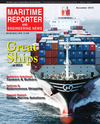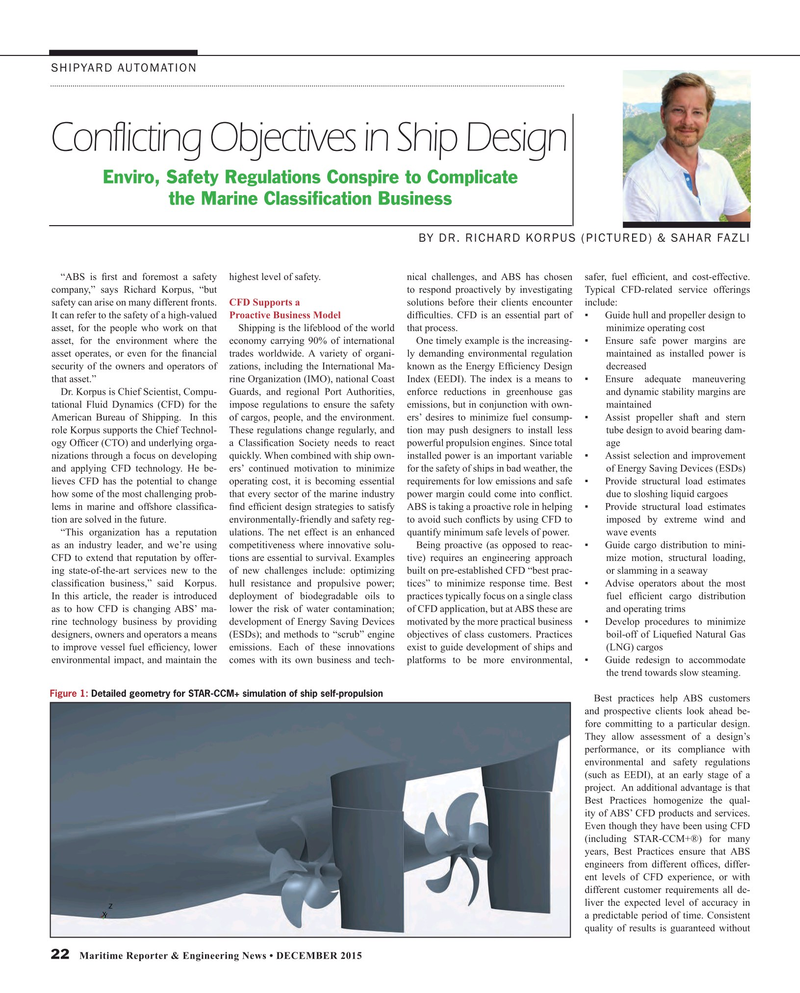
Page 22: of Maritime Reporter Magazine (December 2015)
Great Ships of 2015
Read this page in Pdf, Flash or Html5 edition of December 2015 Maritime Reporter Magazine
SHIPYARD AUTOMATION
Conflicting Objectives in Ship Design
Enviro, Safety Regulations Conspire to Complicate the Marine Classi? cation Business
BY DR. RICHARD KORPUS (PICTURED) & SAHAR FAZLI “ABS is ? rst and foremost a safety highest level of safety. nical challenges, and ABS has chosen safer, fuel ef? cient, and cost-effective. company,” says Richard Korpus, “but to respond proactively by investigating Typical CFD-related service offerings safety can arise on many different fronts. CFD Supports a solutions before their clients encounter include:
It can refer to the safety of a high-valued Proactive Business Model dif? culties. CFD is an essential part of ? Guide hull and propeller design to asset, for the people who work on that Shipping is the lifeblood of the world that process. minimize operating cost asset, for the environment where the economy carrying 90% of international One timely example is the increasing- ? Ensure safe power margins are asset operates, or even for the ? nancial trades worldwide. A variety of organi- ly demanding environmental regulation maintained as installed power is security of the owners and operators of zations, including the International Ma- known as the Energy Ef? ciency Design decreased that asset.” rine Organization (IMO), national Coast Index (EEDI). The index is a means to ? Ensure adequate maneuvering
Dr. Korpus is Chief Scientist, Compu- Guards, and regional Port Authorities, enforce reductions in greenhouse gas and dynamic stability margins are tational Fluid Dynamics (CFD) for the impose regulations to ensure the safety emissions, but in conjunction with own- maintained
American Bureau of Shipping. In this of cargos, people, and the environment. ers’ desires to minimize fuel consump- ? Assist propeller shaft and stern role Korpus supports the Chief Technol- These regulations change regularly, and tion may push designers to install less tube design to avoid bearing dam- ogy Of? cer (CTO) and underlying orga- a Classi? cation Society needs to react powerful propulsion engines. Since total age nizations through a focus on developing quickly. When combined with ship own- installed power is an important variable ? Assist selection and improvement and applying CFD technology. He be- ers’ continued motivation to minimize for the safety of ships in bad weather, the of Energy Saving Devices (ESDs) lieves CFD has the potential to change operating cost, it is becoming essential requirements for low emissions and safe ? Provide structural load estimates how some of the most challenging prob- that every sector of the marine industry power margin could come into con? ict. due to sloshing liquid cargoes lems in marine and offshore classi? ca- ? nd ef? cient design strategies to satisfy ABS is taking a proactive role in helping ? Provide structural load estimates tion are solved in the future. environmentally-friendly and safety reg- to avoid such con? icts by using CFD to imposed by extreme wind and “This organization has a reputation ulations. The net effect is an enhanced quantify minimum safe levels of power. wave events as an industry leader, and we’re using competitiveness where innovative solu- Being proactive (as opposed to reac- ? Guide cargo distribution to mini-
CFD to extend that reputation by offer- tions are essential to survival. Examples tive) requires an engineering approach mize motion, structural loading, ing state-of-the-art services new to the of new challenges include: optimizing built on pre-established CFD “best prac- or slamming in a seaway classi? cation business,” said Korpus. hull resistance and propulsive power; tices” to minimize response time. Best ? Advise operators about the most
In this article, the reader is introduced deployment of biodegradable oils to practices typically focus on a single class fuel ef? cient cargo distribution as to how CFD is changing ABS’ ma- lower the risk of water contamination; of CFD application, but at ABS these are and operating trims rine technology business by providing development of Energy Saving Devices motivated by the more practical business ? Develop procedures to minimize designers, owners and operators a means (ESDs); and methods to “scrub” engine objectives of class customers. Practices boil-off of Lique? ed Natural Gas to improve vessel fuel ef? ciency, lower emissions. Each of these innovations exist to guide development of ships and (LNG) cargos environmental impact, and maintain the comes with its own business and tech- platforms to be more environmental, ? Guide redesign to accommodate the trend towards slow steaming.
Figure 1: Detailed geometry for STAR-CCM+ simulation of ship self-propulsion
Best practices help ABS customers and prospective clients look ahead be- fore committing to a particular design.
They allow assessment of a design’s performance, or its compliance with environmental and safety regulations (such as EEDI), at an early stage of a project. An additional advantage is that
Best Practices homogenize the qual- ity of ABS’ CFD products and services.
Even though they have been using CFD (including STAR-CCM+®) for many years, Best Practices ensure that ABS engineers from different of? ces, differ- ent levels of CFD experience, or with different customer requirements all de- liver the expected level of accuracy in a predictable period of time. Consistent quality of results is guaranteed without 22 Maritime Reporter & Engineering News • DECEMBER 2015
MR #12 (18-25).indd 22 12/4/2015 11:32:50 AM

 21
21

 23
23
